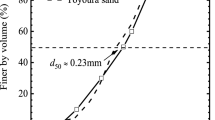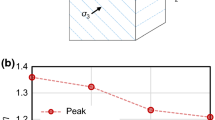Abstract
A comprehensive experimental study has been made on angular sand to investigate various aspects of mechanical behavior. A hollow cylinder torsion testing apparatus is used in this program to apply a range of stress conditions on this angular quartzitic fine sand under monotonic drained shear. The effect of the magnitude and inclination of the principal stresses on an element of sand is studied through these experiments. This magnitude and inclination of the principal stresses are presented as an “ensemble measure of fabric in sands”. This ensemble measure of fabric in the sands evolves through the shearing process, and reaches the final state, which indeed has a unique fabric. The sand shows significant variation in strength with changing inclination of the principal stresses. The locus of the final stress state in principal stress space is also mapped from these series of experiments. Additional aspects of non-coaxiality, a benchmarking exercise with a few constitutive models is presented here. This experimental approach albeit indirect shows that a unique state which is dependent on the fabric, density and confining stress exists. This suite of experiments provides a well-controlled data set for a clear understanding on the mechanical behavior of sands.















Similar content being viewed by others
References
Kirkpatrick, W.M.: The condition of failure of sands. Proceedings, 4th International Conference on Soil Mechanics and Foundation Engineering, London, vol. 1, pp. 172–178 (1957)
Dakoulas, P., Sun, Y.: Fine ottawa sand—experimental behaviour and theoretical predictions. J. Geotech. Eng. (ASCE) 118(12), 1906–1923 (1992)
Arthur, J.R.F., Menzies, K.B.: Inherant anisotropy in a sand. Geotechnique 22(1), 115–128 (1972)
Arthur, J.R.F., Chua, K.S., Dunstan, T.: Induced anisotropy in a sand. Geotechnique 27(1), 13–30 (1977)
Bishop, A.W.: The strength of soils as engineering materials. Geotechnique 16(2), 91–130 (1966)
Sayao, A., Vaid, Y.P.: Effect of intermediate principal stress on the deformation response of sand. Can. Geotech. J. 33, 822–828 (1996)
Miura, K., Miura, S., Toki, S.: Deformation behavior of anisotropic dense sand under principal stress axes rotation. Soils Found. 26(4), 36–52 (1986)
Lade, P.V., Rodriguez, N.M., Van Dyck, E.J.: Effects of principal stress directions on 3D failure conditions in cross-anisotropic sand. J. Geotech. Eng. (ASCE) 140(2),04013001 1–12 (2013)
Oda, M., Iwashita, K.: Mechanics of Granular Materials—An Introduction. Balkema Publishers, Leiden (1999)
Gao, Z., Zhao, J., Li, X.S., Dafalias, Y.F.: A critical state sand plasticity model accounting for fabric evolution. Int. J. Numer. Anal. Methods Geomech. 38, 370–390 (2014)
Fonseca, J., O’Sullivan, C., Coop, M.R., Lee, P.D.: Quantfying the evolution of soil fabric during shearing using scalar parameters. Geotechnique 63(10), 818–829 (2013)
Hasan, A., Alshibli, K.: Experimental assessment of 3D particle-to-particle interaction within sheared sand using synchrotron microtomography. Geotechnique 60(5), 369–379 (2010)
Symes, M.J., Gens, A., Hight, D.W.: Drained principal stress rotation in saturated sand. Geotechnique 38(1), 59–81 (1988)
Pradel, D., Ishihara, K., Gutierrez, M.: Yielding and flow of sand under principal stress axes rotation. Soils Found. 30(1), 87–99 (1990)
Gutierrez, M., Ishihara, K.: Non-coaxiality and energy dissipation in granular materials. Soils Found. 40(2), 49–59 (2000)
Cai, Y., Yu, H., Wanatowski, D., Li, X.: Noncoaxial behavior of sand under various stress paths. J. Geotech. Eng. (ASCE) 139(8), 1381–1395 (2013)
Hight, D.W., Gens, A., Symes, M.J.: The development of a new hollow cylinder apparatus for investigating the effects of principal stress rotation in soils. Geotechnique 33(4), 355–383 (1983)
ASTM D854: standard test methods for specific gravity of soil solids by water pycnometer (2010)
Krumbein, W.C.: Measurement and geological significance of shape and roundness of sedimentary particles. J. Sediment. Petrol. 11(2), 64–72 (1941)
Powers, M.C.: A new roundness scale for sedimentary particles. J. Sediment. Petrol. 23(2), 117–119 (1953)
Cho, G.C., Dodds, J., Santamarina, J.C.: Particle shape effects on packing density, stiffness, and strength: natural and crushed sands. J. Geotech. Geoenviron. Eng. 132(5), 591–602 (2006)
ASTM D4253: standard test methods for maximum index density and unit weight of soils using a vibratory table (2006)
ASTM D4254: standard test methods for minimum index density and unit weight of soils and calculation of relative density (2006)
Vaid, Y.P., Negussey, D.: Relative density of pluviated sand samples. Soils Found. 24(2), 101–105 (1984)
Cresswell, A., Barton, M.E., Brown, R.: Determining the maximum density of sands by pluviation. Geotech. Test. J. (GTJODJ) 22(4), 324–328 (1999)
Sayao, A., Vaid, Y.P.: A critical assessment of stress non uniformities in hollow cylinder test specimens. Soils Found. 31(1), 60–72 (1991)
Gutierrez, M., Ishihara, K., Towhata, I.: Flow theory for sand during rotation of principal stress direction. Soils Found. 31(4), 121–132 (1991)
Nakata, Y., Hyodo, M., Murata, H., Yasufuku, N.: Flow deformation of sands subjected to principal stress rotation. Soils Found. 38(2), 115–128 (1998)
Skempton, A.W.: The pore-pressure coefficients A and B. Geotechnique 4(4), 143–147 (1954)
Pietruszczak, S.: Fundamentals of Plasticity in Geomechanics. CRC Press/Balkema, Boca Raton (2010)
Atkinson, J.H., Bransby, P.L.: The Mechanics of Soils—An Introduction to Critical State Soil Mechanics. Mcgraw Hill Book Co. Ltd, Maidenhead (1982)
Been, K., Jefferies, M.: Stress-dilatancy in very loose sand. Can. Geotech. J. 41, 972–989 (2004)
Kandasami, R.K., Murthy, T.G.: Effect of confining pressure on small strain stiffness properties of cauvery delta sand. GANGA (IGC) Conf. Proc. 1, 1–6 (2013)
Davis, R.O., Selvadurai, A.P.S.: Plasticity and Geomechanics. Cambridge University Press, Cambridge (2002)
Rao, K.K., Nott, P.R.: An Introduction to Granular Flow. Cambridge University Press, Cambridge (2008)
Schofield, A., Wroth, C.P.: Critical State Soil Mechanics. McGraw-Hill, London (1968)
Lade, P.V.: Elasto-plastic stress–strain theory for cohesionless soil with curved yield surfaces. Int. J. Solids Struct. 13(11), 1019–1035 (1977)
Lade, P.: Estimating parameters from a single test for the three-dimensional failure criterion for frictional materials. J. Geotech. Geoenviron. Eng. 140(8), 04014038 (2014)
Li, X., Yu, H.S.: Interpretation of loading direction on the behaviour of anisotropic granular materials. Int. J. Eng. Sci. 47(11–12), 1284–1296 (2009)
Zhao, J., Guo, N.: Unique critical state characteristics in granular media considering fabric anisotropy. Geotechnique 63(8), 695–704 (2013)
Evans, T.M., Frost, J.D.: Multiscale investigation of shear bands in sand: physical and numerical experiments. Int. J. Numer. Anal. Meth. Geomech. 34(15), 1634–1650 (2010)
Oda, M., Kazama, H.: Microstructure of shear bands and its relation to the mechanisms of dilatancy and failure of dense granular soils. Geotechnique 48(4), 465–481 (1998)
Lam, W., Tatsuoka, F.: Effects of initial anisotropic fabric and \(\upsigma _{2}\) on strength and deformation characteristics of sand. Soils Found. 28(1), 89–106 (1988)
Arthur, J.R.F., Phillips, A.B.: Homogeneous and layered sand in triaxial compression. Geotechnique 25(4), 799–815 (1975)
Ochiai, H., Lade, P.V.: Three-dimensional behavior of sand with anisotropic fabric. J. Geotech. Eng. (ASCE) 109(10), 1313–1328 (1983)
Oda, M., Koishikawa, I., Higuchi, T.: Experimental study of anisotropic shear strength of sand by plane strain test. Soils Found. 18(1), 25–38 (1978)
Li, X.S., Dafalias, Y.F.: Anisotropic critical state theory: the role of fabric. J. Eng. Mech. (ASCE) 138(3), 263–275 (2012)
Acknowledgments
This work was supported in part by the Dept. of Science and Technology, Govt. of India Grant No. SR-CE-0057-2010. This support is gratefully acknowledged.
Author information
Authors and Affiliations
Corresponding author
Appendix
Appendix
where \({\uptheta }\) varies from
where \({\upvarphi }\) is the friction angle at the final stress state
where,
-
\({\upsigma }_{\mathrm{z}}\) is the axial stress
-
\({\upsigma }_{{\uptheta }}\) is the tangential stress
-
\({\upsigma }_{\mathrm{r}}\) is the radial stress
-
\({\uptau }_{\uptheta \mathrm{z}}\) is the shear stress along \({\uptheta }\hbox {z}\) plane
-
\(\hbox {r}_{\mathrm{o}}\) is the external radius of the specimen
-
\(\hbox {r}_{\mathrm{i}}\) is the internal radius of the specimen
-
\(\hbox {u}_{\mathrm{o}}\) is the external radial displacement
-
\(\hbox {u}_{\mathrm{i}}\) is the internal radial displacement
-
H is the initial height of the specimen
-
\(\Delta \hbox {H}\) is the change in axial displacement
-
\(\hbox {J}_{2}\) is the second deviatoric stress invariant
-
\({\upeta }\) is the stress ratio
-
\({\uptau }_{\mathrm{oct}},\, {\upgamma }_{\mathrm{oct}}\) is the octahedral shear stress and strain
-
\({\uptheta }\) is the Lode angle
-
\(\hbox {e}_{\max }\)—maximum void ratio the material can achieve
-
\(\hbox {e}_{\min }\)—minimum void ratio the material can achieve
-
\(\hbox {e}_{\mathrm{nat}}\)—void ratio at which the specimen is prepared

Pressure ratio at the critical/final state obtained from the series #1 and series #2 experiments. This ratio was used to identify the level of stress non-uniformity in specimen. Guitterez et al. [27] and Nakata et al. [28] have recommended a range \(0.75 \, < \, \hbox {P}_{\mathrm{i}}/\hbox {P}_{\mathrm{o}}< \, 1.3\). This range of pressures was maintained in the tests performed here. However, at the critical/final state the specimen with b = 0, \({\upalpha }\,=\,75^{\circ },\, 90^{\circ }\) and b = 1, \({\upalpha }\,=\,0^{\circ }\) violate this condition. A note to this effect has been made in the figures.
Rights and permissions
About this article
Cite this article
Kandasami, R.K., Murthy, T.G. Experimental studies on the influence of intermediate principal stress and inclination on the mechanical behaviour of angular sands. Granular Matter 17, 217–230 (2015). https://doi.org/10.1007/s10035-015-0554-4
Received:
Published:
Issue Date:
DOI: https://doi.org/10.1007/s10035-015-0554-4




